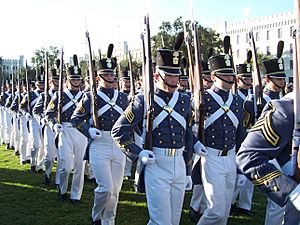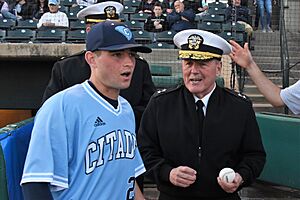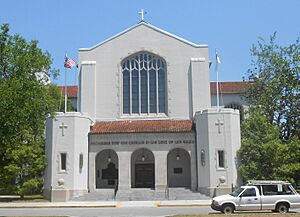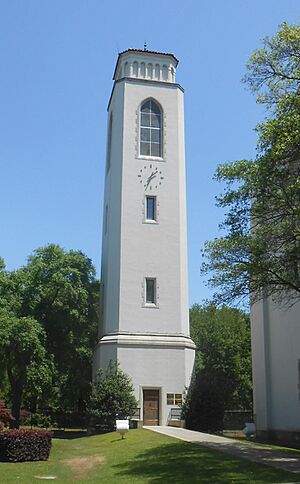The Citadel facts for kids
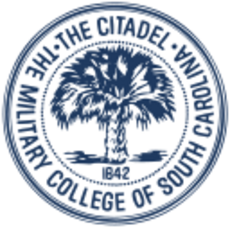 |
|
|
Former name
|
South Carolina Military Academy |
|---|---|
| Motto | Honor • Duty • Respect |
| Type | Public senior military college |
| Established | 1842 |
|
Academic affiliations
|
Sea-grant |
| Endowment | $423.6 million (2021) |
| President | GEN Glenn M. Walters, USMC (Ret.) |
| Provost | BG Sally C. Selden, SCM |
| Commandant of Cadets | COL Thomas J. Gordon, USMC, (Ret.) |
|
Academic staff
|
225 |
| Students | 3,721 |
| Postgraduates | 1,026 |
| Location |
,
,
United States
32°47′50″N 79°57′40″W / 32.79722°N 79.96111°W |
| Campus | Urban, 300 acres (121 ha) |
| Colors | Citadel Blue and White |
| Nickname | Bulldogs |
|
Sporting affiliations
|
NCAA Division I – SoCon |
| Mascot | Spike Live Mascots: General 3 (affectionately known as G3) |
 |
|
The Citadel Military College of South Carolina, often called The Citadel, is a public military college in Charleston, South Carolina. It was started in 1842. It is one of the oldest of the six senior military colleges in the United States. The Citadel was first created to educate young men. It also helped protect state arsenals in Columbia and Charleston.
The Citadel offers many different study programs. These are grouped into six main schools: Business, Education, Engineering, Humanities and Social Sciences, Science, and Mathematics. Students can earn bachelor's degrees in 38 main subjects. They can also choose from 55 minor subjects.
The military program is for cadets who live on campus. They work towards their bachelor's degrees. The Citadel also has programs for students who are not cadets. These include undergraduate and graduate degrees. Some programs are offered in the evenings or online.
Contents
- History of The Citadel
- Academics and Learning
- Cadet Life
- Athletics and Sports
- Traditions and Values
- Campus and Landmarks
- Alumni and Graduates
History of The Citadel
The Citadel began in 1842. It was first known as the South Carolina Military Academy. It had two locations: one in Charleston and one in Columbia. The Columbia location was destroyed during the American Civil War. The Charleston location reopened in 1882.
During the Civil War, Citadel cadets formed a military unit. They fought in several battles. In January 1861, cadets fired the first shots of the war. They shot at a Union ship trying to resupply Fort Sumter. The Citadel is one of only five American colleges to receive a battle streamer. This award is for its students' service during wartime.
In 1922, the school moved to its current campus. This new campus is on the Ashley River in Charleston. The Citadel has grown a lot since then. During World War II, many Citadel graduates served in the military.
The Citadel has become more diverse over the years. The first black cadet joined in 1966. The first woman to graduate from a graduate program was Maxine Hudson in 1969. The first Native American students graduated in 1971. In 1999, Nancy Mace became the first woman to graduate from the Corps of Cadets program. In 2018, Sarah J. Zorn became the first woman to lead the South Carolina Corps of Cadets.
Since 1989, many buildings on campus have been updated. The school has also added new courses. These include Mechanical Engineering, Computer Science, and Nursing. Citadel cadets and alumni have served in every U.S. military action. This includes conflicts from the Mexican–American War to today.
Academics and Learning
The Citadel organizes its studies into five main schools. Each school has a dean who leads it.
Business School
The Baker School of Business has three departments. These include Accounting, Finance, Management, and Marketing. It offers degrees in Business Administration. More cadets choose Business Administration than any other major. The school moved to a new building called Bastin Hall in 2021.
Education School
The Zucker Family School of Education offers programs for future teachers. It has both undergraduate and graduate degrees. The school was named after the Zucker Family in 2014. This was in honor of a large donation for education programs.
Engineering School
The School of Engineering has four departments. These include Civil, Electrical, and Mechanical Engineering. It is one of the oldest engineering programs in the country. The school has added new engineering degrees in recent years. In 2018, it added a Construction Engineering program. U.S. News & World Report has often ranked The Citadel's engineering program among the top in the nation.
Humanities and Social Sciences School
The School of Humanities and Social Sciences has seven departments. These include Criminal Justice, English, History, and Political Science. This school offers many majors and minors. It also has graduate programs in areas like cybersecurity. The school is recognized as a National Center of Academic Excellence in Cyber Defense.
Science and Mathematics School
The Swain Family School of Science and Mathematics has seven departments. These include Biology, Chemistry, Computer Sciences, and Nursing. This school, along with Education and Engineering, supports the STEM Center of Excellence. This center hosts events like the annual Storm The Citadel week. The school was named for the Swain Family in 2018.
Learning Programs
The Citadel offers different ways to earn a degree. These are for cadets, active duty military, veterans, and civilians.
Corps of Cadets Program
The South Carolina Corps of Cadets is a full-time program. Students live on campus in a military setting. This program focuses on developing students as leaders.
Graduate College Programs
The Citadel Graduate College (CGC) offers evening and online programs. It provides bachelor's, master's, and specialist degrees. These programs are designed for working students. The CGC has over 25 graduate programs.
College Transfer Programs
The Citadel Graduate College also has 12 majors for transfer students. Students can complete their first two years at another college. Then they transfer credits to The Citadel for their final two years. Six majors are offered in this 2+2 program. These include Civil Engineering and Nursing.
Enlisted Commissioning Programs
The Citadel has programs for enlisted Navy and Marine Corps members. These programs help them become officers. The first Marine Enlisted Commissioning Education Program (MECEP) started at The Citadel in 1973.
Leadership Training
ROTC Programs
All cadets must take at least two years of ROTC training. This training is for branches like the Army, Navy, and Air Force. Cadets are not required to join the military after graduating. However, about 35% of graduates do become officers.
Coast Guard Auxiliary University Program
Cadets interested in the United States Coast Guard can join this program. It helps them learn about Coast Guard careers. The Citadel's program was one of the first in the nation.
Krause Center for Leadership and Ethics
This center offers classes and training. It teaches students about leadership, ethics, and service. It also helps cadets find community service opportunities.
Cadet Officer Leadership School
High school JROTC students can attend this school at The Citadel. It provides officer training for their JROTC units. Students learn about military drill and discipline.
Rankings and Recognition
The Citadel is often recognized for its quality.
- In 2022, U.S. News & World Report ranked The Citadel highly. It was ranked first for Best College for Veterans in the South.
- Money magazine ranked The Citadel 78th out of 744 U.S. colleges in 2022. This ranking looked at affordability and graduate earnings.
- Forbes ranked The Citadel 201st among top U.S. colleges for 2024-25. It was also ranked 93rd among public colleges.
- In 2016, The Economist magazine ranked The Citadel 94th for graduate earnings.
Cadet Life
Students who want to join the South Carolina Corps of Cadets must meet certain standards. This includes physical fitness and test scores. Cadets live on campus in barracks for all four years. They cannot be married.
A typical day for cadets includes physical training in the morning and afternoon. They also have military instruction on leadership and discipline. After classes, the day usually ends with a formation and a mandatory study period.
First-year cadets are called "knobs." This is because male cadets used to shave their heads. Now, they only shave their heads during their first week. The Fourth Class System helps new cadets learn discipline and core values. The Citadel works to prevent hazing. Cadets must sign a statement agreeing to report any hazing.
Cadets who break rules can receive punishments. These include "tours" (marching with a rifle) or "confinements" (staying in their room).
The Regimental Band and Pipes
The Regimental Band was formed in 1909. It is a key part of formal parades. The band and pipes are known internationally. They have performed at the Edinburgh Military Tattoo in Scotland multiple times. They also performed in Presidential Inaugural parades.
Summerall Guards
The Summerall Guards are a silent drill team. They are made up of 61 junior cadets chosen each spring. The team performs a special routine called The Citadel Series. This routine has been performed at many major events. These include presidential inaugurations and NFL games.
Honors Program
The Honors Program is for cadets with excellent grades. It offers special courses and small classes. The program helps cadets apply for scholarships. Since 1992, The Citadel has had many Fulbright Scholars and Truman Scholars. The program also helps cadets study abroad. They can also do internships in places like Washington, D.C..
Student Newspaper
The Brigadier is The Citadel's student newspaper. It started in 1924. It is mainly published online as a blog. Printed copies are available for major events.
Athletics and Sports
The Citadel competes in NCAA Division I sports. It has been a member of the Southern Conference since 1936. The school mascot is the Bulldog. Men's sports include football, basketball, baseball, and wrestling. Women's sports include volleyball, soccer, and track. There are also many club sports like lacrosse and ice hockey.
The The Citadel Bulldogs baseball team has won many championships. In 1990, they made their first trip to the College World Series. Many alumni have played in Major League Baseball.
The football team has won four Southern Conference Championships. They have also played in the Football Championship Subdivision playoffs. The 2015 team won nine games, including a victory over South Carolina. Many alumni have played in professional football leagues.
The wrestling team has sent many members to the NCAA tournament. The Citadel's rifle team has won national championships.
Traditions and Values
The Honor Code
The Citadel has an Honor Code. It states that students must not lie, cheat, or steal. They also must not tolerate those who do. A cadet-run Honor Court investigates any rule breaking. The penalty can be expulsion.
Class Rings
Students who graduate from The Citadel can wear the school's ring. This ring symbolizes their achievements. The rings are 10 karat gold. The design is the same for every class, except for the year.
Campus and Landmarks
The Citadel campus is about 300 acres. It is located on the Ashley River. The buildings are in a Spanish Moorish style. They are grouped around a large grass parade ground. The campus has classrooms, barracks, a mess hall, a chapel, and a library.
Padgett-Thomas Barracks
Padgett-Thomas Barracks was the first building on campus. It was rebuilt in 2004. Its tall tower is a main feature of the campus. It can house up to 560 cadets.
Summerall Chapel
The Summerall Chapel was built in 1938. It was named after Citadel president General Charles Pelot Summerall. Inside, there are 30 beautiful stained glass windows. They show scenes from the life of Jesus Christ.
The Daniel Library
The Daniel Library opened in 1960. It was renamed in 1972 to honor Charles E. Daniel and Robert Hugh Daniel. The library has over 200,000 books. It also has access to many online journals. The third floor has the campus archives and museum.
Campus Landmarks
HMS Seraph Monument
This monument honors the British submarine HMS Seraph. This submarine was involved in important missions during World War II. The monument shows the friendship between the U.S. and the UK.
Howie Bell Tower and Carillon
This tower honors Major Thomas D. Howie. He was a Citadel alumnus and a hero in World War II. He was known as "The Major of St Lo." The tower has 59 bronze bells.
The Citadel War Memorial
This memorial was dedicated in 2017. It lists the names of 759 Citadel alumni. These alumni died in U.S. wars, from the Mexican-American War to recent conflicts.
General Mark Clark Gravesite
General Mark Wayne Clark is buried on campus. He was the Citadel President from 1954 to 1965. He was a famous U.S. Army General during World War II and the Korean War.
The Citadel Ring Statue
Near the main entrance is a giant replica of The Citadel ring. This ring is a very important symbol for graduates.
Monuments to the Armed Forces
On the parade ground, there are monuments for each military service. They honor Citadel alumni who served in the military. These include a Marine landing craft, an Army tank, and an Air Force jet.
Alumni and Graduates
The Citadel has many famous graduates. These include former U.S. Ambassador to Brazil Langhorne A. Motley and U.S. Senator Ernest Hollings. Well-known authors Pat Conroy and Robert Jordan also graduated from The Citadel. Other alumni include athletes, coaches, and astronauts.
About 35% of cadet graduates become military officers. Many others go on to graduate school. Over the years, 299 Citadel alumni have become high-ranking military officers. Alumni have served in the military of other countries too.
Citadel alumni have died in action in many wars. These include the Mexican-American War, Civil War, World War I, World War II, Korean War, Vietnam War, and conflicts in Iraq and Afghanistan.



